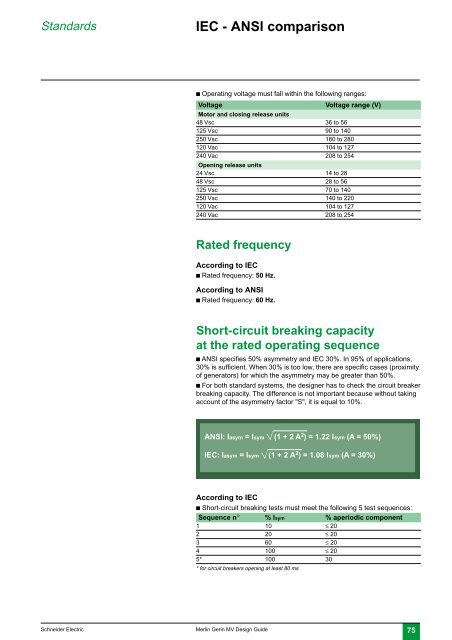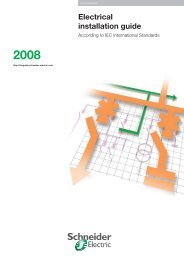MV design guide - Schneider Electric
MV design guide - Schneider Electric
MV design guide - Schneider Electric
You also want an ePaper? Increase the reach of your titles
YUMPU automatically turns print PDFs into web optimized ePapers that Google loves.
Standards<br />
IEC - ANSI comparison<br />
c Operating voltage must fall within the following ranges:<br />
Voltage<br />
Voltage range (V)<br />
Motor and closing release units<br />
48 Vsc 36 to 56<br />
125 Vsc 90 to 140<br />
250 Vsc 180 to 280<br />
120 Vac 104 to 127<br />
240 Vac 208 to 254<br />
Opening release units<br />
24 Vsc 14 to 28<br />
48 Vsc 28 to 56<br />
125 Vsc 70 to 140<br />
250 Vsc 140 to 220<br />
120 Vac 104 to 127<br />
240 Vac 208 to 254<br />
Rated frequency<br />
According to IEC<br />
c Rated frequency: 50 Hz.<br />
According to ANSI<br />
c Rated frequency: 60 Hz.<br />
Short-circuit breaking capacity<br />
at the rated operating sequence<br />
c ANSI specifies 50% asymmetry and IEC 30%. In 95% of applications,<br />
30% is sufficient. When 30% is too low, there are specific cases (proximity<br />
of generators) for which the asymmetry may be greater than 50%.<br />
c For both standard systems, the <strong>design</strong>er has to check the circuit breaker<br />
breaking capacity. The difference is not important because without taking<br />
account of the asymmetry factor "S", it is equal to 10%.<br />
ANSI: Iasym = Isym (1 + 2 A 2 ) = 1.22 Isym (A = 50%)<br />
IEC: Iasym = Isym (1 + 2 A 2 ) = 1.08 Isym (A = 30%)<br />
According to IEC<br />
c Short-circuit breaking tests must meet the following 5 test sequences:<br />
Sequence n° % Isym % aperiodic component<br />
1 10 ≤ 20<br />
2 20 ≤ 20<br />
3 60 ≤ 20<br />
4 100 ≤ 20<br />
5* 100 30<br />
* for circuit breakers opening at least 80 ms<br />
<strong>Schneider</strong> <strong>Electric</strong><br />
Merlin Gerin <strong>MV</strong> Design Guide<br />
75
















